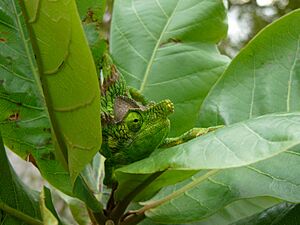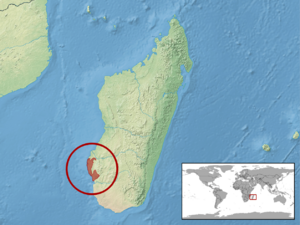Antimena chameleon facts for kids
Quick facts for kids Antimena chameleon |
|
|---|---|
 |
|
| male | |
| Conservation status | |
| Scientific classification | |
| Genus: |
Furcifer
|
| Species: |
antimena
|
 |
|
| Synonyms | |
|
|
The Antimena chameleon (Furcifer antimena) is a special type of chameleon. It is only found in the southwest part of Madagascar, a large island off the coast of Africa. A French scientist named Alfred Grandidier first described this chameleon in 1872.
Contents
Where the Antimena Chameleon Lives
Its Home in Southwest Madagascar
The Antimena chameleon lives in southwest Madagascar. You can find it in areas like Antsokay, Toliara, and Ankotapiky. These places are usually between 5 and 80 meters (about 16 to 260 feet) above sea level.
Scientists believe this chameleon lives in an area of about 6,310 square kilometers (2,436 square miles). Two rivers, the Onilahy River and the Mangoky River, seem to mark the edges of where these chameleons live.
Why This Chameleon Needs Our Help
The Antimena chameleon is considered a Vulnerable species. This means it is at risk of disappearing. The International Union for Conservation of Nature (IUCN) gave it this status. The main reason is that the forests where it lives are being cut down. People are clearing the land for farming and to make charcoal. This loss of their forest homes means fewer places for the chameleons to live. Because of this, their numbers are believed to be going down.
What the Antimena Chameleon Looks Like
How to Spot a Male or Female
Male Antimena chameleons are usually green. They often have yellow or whitish stripes on their bodies. They also have a special crest on their back. This crest is made of about thirty cone-shaped scales. Each scale is between 3 and 6 millimeters long.
Female Antimena chameleons are a solid dark green color. They do not have the same stripes as the males.
Size and Snout
Male Antimena chameleons can grow quite large. They can reach a maximum length of about 34 centimeters (13 inches). Females are smaller, growing up to about 17 centimeters (6.7 inches) long.
Both males and females have a small projection, like a tiny horn, on the tip of their snout. This projection is bigger and more noticeable on the males than on the females.
How the Antimena Chameleon Lives
Its Daily Life and Habitat
The Antimena chameleon usually lives in dry savannah areas. These are places with thorny bushes and scattered trees. They like to hide among the thorny scrub.
Baby Chameleons
When a female Antimena chameleon is ready to lay eggs, she finds a hidden spot. She buries a group of ten to fifteen eggs in sandy soil. This group of eggs is called a clutch. The baby chameleons hatch from these eggs about a year later.
The Story Behind Its Name
Who Discovered It?
The Antimena chameleon was first described in 1872. This was done by a French scientist and explorer named Alfred Grandidier. The chameleon is commonly known as the Antimena chameleon. This name comes from the species name, antimena.
Other Names for This Chameleon
Over time, scientists have given this chameleon a few different names. These are called synonyms. Some of the older names include Chamaeleo antimena (Grandidier, 1872) and Chamaeleon rhinoceratus lineatus (Methuen & Hewitt, 1913). The name Furcifer antimena was used by Glaw & Vences in 1944.


